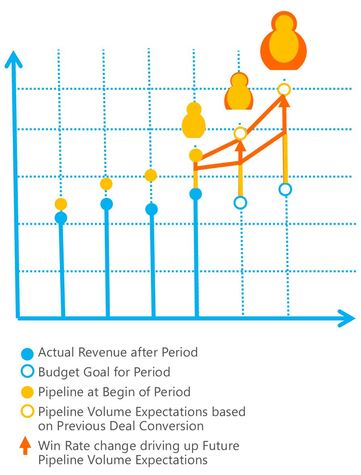The formal concept to manage this challenge in business is called Sales Pipeline Management. It´s bridging today´s deal-by-deal business execution with the projected business attainment on an opportunity-by-opportunity basis. While, it is the shared formal concept for all stakeholders, it allows for different perspectives:
While there are plenty of publications on Pipeline Management, I would like to share some perspective, why Quality must beat Quantity! Ideally, all your opportunities convert to business and contribute to the goal attainment. However, reality is very different. Deals are slipping into future quarters, they close smaller than expected or simply are lost. Let me introduce some commonly used concepts to address the lack of control on the pipeline:
In essence, you can either further mobilize your demand generation engine to put more deals into the pipeline (increase Quantity) or lose less from it (increase WinRate) - either way, you will need to prepare for the unexpected. Important to keep in mind that both approaches are limited by available sales capacity of the organization. As far as the laws of mathematics refer to reality, they are not certain; and as far as they are certain, they do not refer to reality. The Spreadsheet Acrobats will tell you that the required future Pipeline Threshold to hit your future sales target ("pipeline coverage") will be the future target to go plus an % uplift. The amount of required % uplift is defined by the % amount of historically lost deals. In other words, we set the pipeline coverage goal high enough so, we -hopefully- cater for potential future losses.
The mathematical approach alone is not getting you on the safe side. You end up in an unhealthy race fighting lost opportunities with more demand generation. However, the more pipeline volume we expect, the more difficult it is to find sufficient deals and the harder it gets to reach a similar success rate again. Fighting the tendency of dropping WinRates through incremental volume requirements we can call the Matryoshka Effect in Pipeline Coverage Requirements - the Pipeline Coverage targets keep going up while WinRates are trending downwards. In reality, many leaders still prefer to drive the hard fact based, quantitative approach over qualitative coaching. The reason is simple: It´s easier to scale pipeline generation within a sales organization (all hands on deck!"), than coaching sellers, partners and marketing for elevated deal quality. The only way to escape Matryoshka’s appetite for more is by putting focus on the qualitative approach to deals, both on the Demand Generation and on the Deal Management side. Increasing the number of healthy deals (and the healthy meals for Matryoshka) will get your pipeline into a stable, healthy state. Give it a serious try, put focus on the organizational capability and you will be surprised, both by the qualitative and the quantitative effects it triggers.
The very practical approach of Coaching for Pipeline Success [Keith Rosen] works well for me but, Training alone doesn't develop champions. Leaders do!
0 Comments
How come, we seem to struggle with predicting our potential future business attainment? – We are dealing with a so called “Information Inefficiency”, a risk sourcing from an information deficit. It means we don´t know what will happen until it happened. So, in theory gathering information and managing deals on time will mitigate this risk and our forecast accuracy problem is solved. However, the subject is far more complex since we are dealing with people, organizations and respective underlying political dynamics. Science refers to this risk category as “Alignment Inefficiency”. It describes the domain of risk sourcing from conflicting interests and -incentives within an organization. This important fact makes Forecast Management an interesting cultural aspect and sets it apart from sheer business discipline efforts – Forecast Management is all about Leadership! Unarguably, the sales teams play a key role in mastering the forecast accuracy but we should not confuse Deal Management accountability on Seller level or Pipeline Management accountability on Management level with Forecast Management ownership on Leadership suite. Forecasting is a team sport which, when done properly involves your whole organization to varying degree. Teaming up for success requires your people speaking the same language. Are your teams using the same taxonomy, following the same standards in assessing the business and is the final forecast puzzle seamlessly fitting together as one, ultimately reflecting the organizational commitment? Sellers know their customers and deals best. The Bottom-Up approach is a good start but how do you assess required information without additionally distracting your motivated sellers from what they like best, doing business? – Seller Readiness and Deal Coaching are the first priorities. Getting this right, in right dose, is your ticket into a predictable deal management and a solid forecast foundation. The Best Way To Predict The Future Is To Create It! When talking about the next level -the sales management assessment- we are already into the usual conflict of interest – ambition or reality. Clear answer: ambition belongs into the budget, business plan and the actual deal management, while reality is the main ingredient to the forecast. The Risks (Timing- and Alignment-Risk) remain as variables in the decision making. Having variables means options and scenarios to be considered during the forecast assessment. Will the Risk deal offset another Upside or will the Risks/Upsides add up? … Do I have to adjust my P&L now, based on my Forecast or will the available resource still improve the business outlook in current business period? – It´s not easy but it all requires a deep understanding and clear sight on your business to get it right. The view from the top in an organization provides us with the 360-degree view on the business to precisely navigate the curvy road ahead. Looking back on historic data and trendlines is tempting but also dangerous in anticipating the future. We easily miss the game changing moment in our market. Mark Twain well framed it: “History doesn't repeat itself, but it does rhyme.” Even more so, it generates a false sense of security which distracts from analyzing current business dynamics or going deep on deal progression. Strong management commitment, insights on operational risks, specific deal challenges and visibility on the underlying decision making processes should equip us well to take a balanced decision on our forecast and conclude orchestrated corrective action on our business to come. Finally, measuring Forecast precision is a helpful indication when it comes to supporting a continuous organizational learning process. Using it as an organizational goal, it triggers counterproductive corrective action on the symptoms, not on the cause. The Forecast ought to be your uncompromised view on the future, it will not change the weather nor your business but it allows us to choose where to go or which action to take – cultivate your Forecast integrity with caution, don´t allow to compromise it with dishonesty nor load it with wrong ambition. You can shoot the frog for bad news but like it or not, your Forecast accuracy is ultimately reflecting the level of trust within your organization.
|
Andreas Engelis an experienced business leader working 25+ year in high-tech industry - leading, growing and transforming high-performance sales organizations, balancing short term results with long term strategy to drive new business growth. CATEGORIES
All
ARCHIVES
April 2020
|





